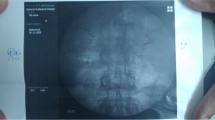Abstract.
The aim of this study was to evaluate and describe MRI epidurography as a new imaging tool. Five volunteers and one patient were investigated with MR epidurography after injection of 20 ml Gd-DPTA solution (1 : 250/1 ml Gd-DPTA/250 ml normal saline). Magnetic resonance epidurography is possible. With fat-suppression techniques, the contrast between Gd-DPTA solution in the epidural space and surrounding soft tissue proved adequate. Using the multiplanar capability of MRI with MR epidurography coronal and sagittal projections similar to conventional epidurography, axial slices comparable to CT epidurography can be obtained. Magnetic resonance epidurography is superior to conventional and CT epidurography. Presently, due to high costs as compared with conventional and CT epidurography, MRI is not suitable for the routine monitoring of peridural catheters, but it may have a place in the future with decreasing costs for MRI and for the evaluation of patients with spine pathology, especially in describing epidural processes.
Similar content being viewed by others
Author information
Authors and Affiliations
Additional information
Received 30 September 1997; Revision received 13 January 1998; Accepted 23 January 1998
Rights and permissions
About this article
Cite this article
Tomczak, R., Seeling, W., Mergo, P. et al. Magnetic resonance epidurography with gadolinium-DTPA. Eur Radiol 8, 1452–1454 (1998). https://doi.org/10.1007/s003300050573
Published:
Issue Date:
DOI: https://doi.org/10.1007/s003300050573




